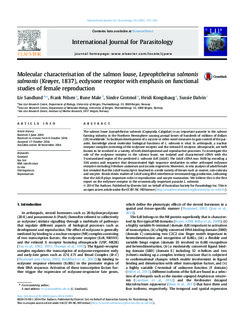| dc.contributor.author | Sandlund, Liv | |
| dc.contributor.author | Nilsen, Frank | |
| dc.contributor.author | Male, Rune | |
| dc.contributor.author | Grotmol, Sindre | |
| dc.contributor.author | Kongshaug, Heidi | |
| dc.contributor.author | Dalvin, Sussie | |
| dc.date.accessioned | 2015-04-15T09:06:49Z | |
| dc.date.available | 2015-04-15T09:06:49Z | |
| dc.date.issued | 2014-11-20 | |
| dc.identifier.citation | Sandlund, L., Nilsen, F., Male, R., Grotmol, S., Kongshaug, H., & Dalvin, S. (2015). Molecular characterisation of the salmon louse, Lepeophtheirus salmonis salmonis (Krøyer, 1837), ecdysone receptor with emphasis on functional studies of female reproduction. International Journal for Parasitology, 45(2–3), 175-185. doi: http://dx.doi.org/10.1016/j.ijpara.2014.10.003 | nb_NO |
| dc.identifier.issn | 0020-7519 | |
| dc.identifier.issn | 1879-0135 | |
| dc.identifier.uri | http://hdl.handle.net/11250/281746 | |
| dc.description.abstract | The salmon louse Lepeophtheirus salmonis (Copepoda, Caligidae) is an important parasite in the salmon farming industry in the Northern Hemisphere causing annual losses of hundreds of millions of dollars (US) worldwide. To facilitate development of a vaccine or other novel measures to gain control of the parasite, knowledge about molecular biological functions of L. salmonis is vital. In arthropods, a nuclear receptor complex consisting of the ecdysone receptor and the retinoid X receptor, ultraspiracle, are well known to be involved in a variety of both developmental and reproductive processes. To investigate the role of the ecdysone receptor in the salmon louse, we isolated and characterised cDNA with the 5′untranslated region of the predicted L. salmonis EcR (LsEcR). The LsEcR cDNA was 1608 bp encoding a 536 amino acid sequence that demonstrated high sequence similarities to other arthropod ecdysone receptors including Tribolium castaneum and Locusta migratoria. Moreover, in situ analysis of adult female lice revealed that the LsEcR transcript is localised in a wide variety of tissues such as ovaries, sub-cuticula and oocytes. Knock-down studies of LsEcR using RNA interference terminated egg production, indicating that the LsEcR plays important roles in reproduction and oocyte maturation. We believe this is the first report on the ecdysone receptor in the economically important parasite L. salmonis. | nb_NO |
| dc.language.iso | eng | nb_NO |
| dc.publisher | Elsevier | nb_NO |
| dc.rights | Navngivelse-Ikkekommersiell-IngenBearbeidelse 3.0 Norge | * |
| dc.rights.uri | http://creativecommons.org/licenses/by-nc-nd/3.0/no/ | * |
| dc.title | Molecular characterisation of the salmon louse, Lepeophtheirus salmonis salmonis (Krøyer, 1837), ecdysone receptor with emphasis on functional studies of female reproduction | nb_NO |
| dc.type | Journal article | nb_NO |
| dc.type | Peer reviewed | nb_NO |
| dc.subject.nsi | VDP::Agriculture and fishery disciplines: 900::Fisheries science: 920::Aquaculture: 922 | nb_NO |
| dc.subject.nsi | VDP::Agriculture and fishery disciplines: 900::Fisheries science: 920::Fish health: 923 | nb_NO |
| dc.source.pagenumber | 175-185 | nb_NO |
| dc.source.volume | 45 | nb_NO |
| dc.source.journal | International journal for parasitology | nb_NO |
| dc.source.issue | 2-3 | nb_NO |
| dc.identifier.doi | 10.1016/j.ijpara.2014.10.003 | |
| dc.relation.project | Norwegian Research Council: 203513 | nb_NO |

